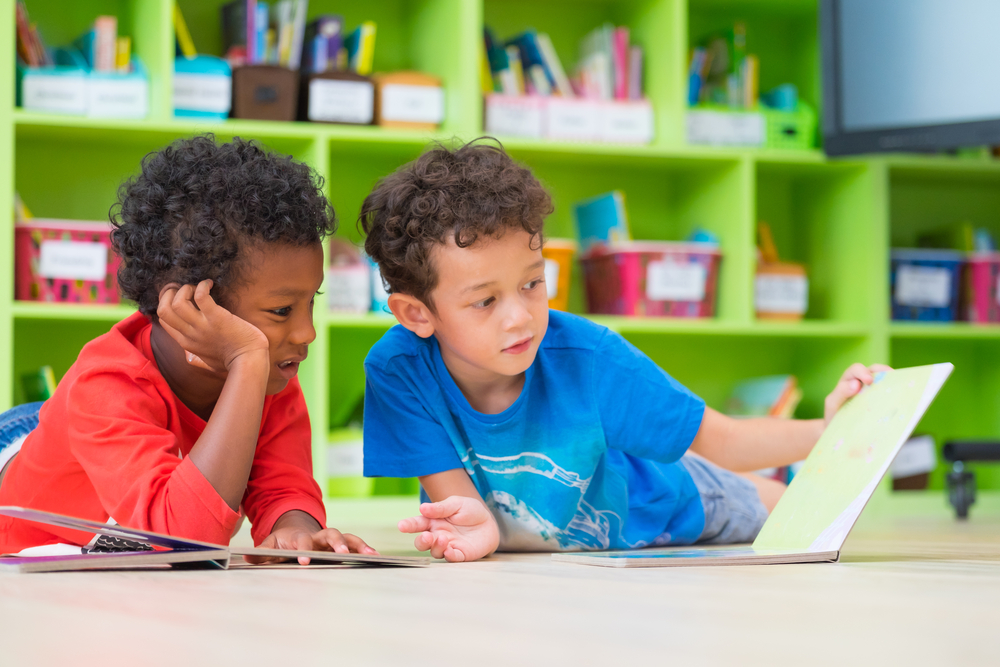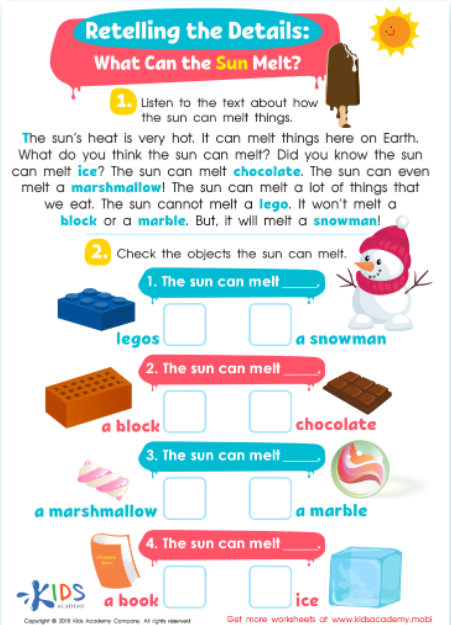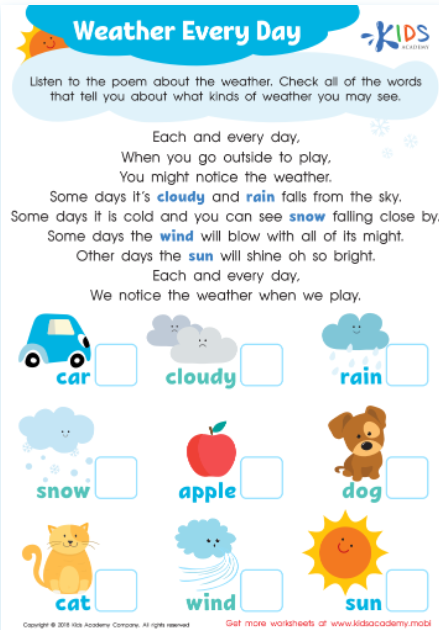-
English
-
English Pre-K
-
Unit 1: Early Literacy Skills
-
ABCs
- Pre-writing Activities
- Letter A
- Letter B
- Letter C
- Letter D
- Letter E
- Letter F
- Letter G
- Letter H
- Letter I
- Letter J
- Letter K
- Letter L
- Letter M
- Letter N
- Letter O
- Letter P
- Letter Q
- Letter R
- Letter S
- Letter T
- Letter U
- Letter V
- Letter W
- Letter X
- Letter Y
- Letter Z
-
Phonological Awareness
- Rhyming Words
- Letter Sounds B, C, D, and F
- Letter Sounds G, H, J, and K
- Letter Sounds L, M, N, and P
- Letter Sounds Q, R, S, and T
- Letter Sounds V, W, X, Y, and Z
- Letter Sounds A, E, and I
- Letter Sounds O and U
- Beginning Sounds
- Matching Letters to Sounds
-
ABCs
-
Unit 2: Vocabulary
-
Common Words
- Sorting Words into Categories
- Color Words
- Verbs and Adjectives
-
Sight Words
- Sight Words 'I' and 'Can'
- Sight Words 'You' and 'Like'
-
Common Words
-
Unit 3: Print Awareness
-
Parts of a Book
- Working with a Book
- Spaces Between Words
- Text and Illustrations
-
Picture Books and Poems
- Picture Book Text Features
- Poem Text Features
- Signs and Labels in the Community
-
Parts of a Book
-
Unit 4: Reading Literature
- Questions About Stories
- Discussing Stories
-
Unit 5: Reading Informational Texts
- Retelling Details in a Text
- Questions About a Text
- Connections Between Events
- Text Features
- Describing Illustrations
-
Unit 1: Early Literacy Skills
-
English Pre-K
-
Math
-
Math for Pre-Kindergarten
-
Logic and Geometry
-
Matching and Sorting
- Same and Different
- Which One Is a Little Different?
- Objects That Go Together
- Sorting by Color and Size
- Sorting The Same Group in Different Ways
- Patterns
-
Shapes
- Shapes in Our Environment
- Naming Shapes Regardless of Size
- Making Shapes in Preschool
- Comparing Shapes
- Relative Positions
- Sorting Shapes
-
Matching and Sorting
-
Early Number Sense
-
Numbers 1–5
- Counting to 3
- Counting to 5
- Arranging Objects up to 3 Objects
- Arranging up to 5 Objects
- Writing Numbers 1–5
-
Numbers 1–5
-
Numbers up to 10
- Counting to 10
- Arranging up to 10 Objects
- Number 0
- Writing Numbers 6–10
- Breaking Down Numbers 6-10
-
Logic and Geometry
-
Math for Pre-Kindergarten
Retelling Details in a Text
Most of what adults read consists of nonfiction text. Newspapers, reports, and online material are where many of us turn for information. We want to expose our youngest readers to this genre early on.
The purpose of reading is to make sense of the text. Do you want your young scholar to be able to know the main topic and the most relevant details? How can we determine if our child is able to do this? Simply asking your child to retell the most important events is one of the first comprehension skills to practice.

Retelling Skills for Pre-K Students
After reading a nonfiction text, follow up with a retelling activity. The key idea and details strand follows students from pre-K through grade 12. The foundational skills involve the basic retelling of a text.
Retelling should not be confused with summarizing. Think of it as a prerequisite to summarizing, synthesizing, and paraphrasing.
When faced with nonfiction text, we want our scholars to recall the main topic and relevant supporting details.
What to Expect at this Stage
Identifying the main topic: Your child should be able to determine the main focus of an article.
Pointing out relevant details: With support and repetition, help your child decide what information to gather. This is a sophisticated skill that needs refinement over time.
Making a personal connection: Pose questions that allow your student to attach new learning to his own life’s experiences.
The Next Level of Skills
Paraphrasing text details: Ultimately, you want your child to be able to internalize and paraphrase a nonfiction text. This requires advanced vocabulary and critical thinking skills. Model the skill for your youngster while understanding that this is simply for exposure. Spend more time focused on directly retelling information from the text.
Making high-level inferences: Implied understanding relies on background knowledge about a topic. You may find that your child can infer information about one text, but can’t carry this skill over to another. This is likely not yet a part of your child’s schema, and your child will need vocabulary development and concept attainment for this topic.
Choosing Appropriate Informational Texts
Focus on nonfiction texts with the following features:
Vivid Photographs: Your child takes cues from photographs. Choose texts with bright vivid photos to capture your young reader’s attention.
Simple Sentences: This is not the time to explore non-literal language and complex sentence structures. The goal for your scholar is to attain the information to retell the most pressing information.
Familiar Subjects: Whenever possible, provide access to texts according to your child’s interest. Expect your child’s interests to change frequently. Cultivate text sets that give fun facts and fresh information.
These resources from Kids Academy are a great way to introduce retelling to your child.
Instructional Strategies to Support Retelling
Your child is currently positioned right in the middle of what Piaget defines as the preoperational stage of development. This means that you need to make learning experiences concrete.
Visual aids outside of the nonfiction article are essential to building lasting knowledge. An anchor chart with definitions of text features will help. Focus on the terms title, photographs, and text.
What Learning Aids Can Be Helpful
Pre-K students find success with the five-finger retell technique. Assign a retelling prompt to each finger as a visual reminder as your child works through this task.
Thumb: What is the topic of this text?
Index, Middle, and Ring Fingers: Identify three supporting details.
Pinky: Make a personal connection to the text.
If you’re wondering where to start, look for nonfiction publications designed for children. Highlights, Scholastic News, Time for Kids, and National Geographic for Kids are commonly used in schools.
By: Monica Edwards
English Language Arts Teacher and Curriculum Writer



